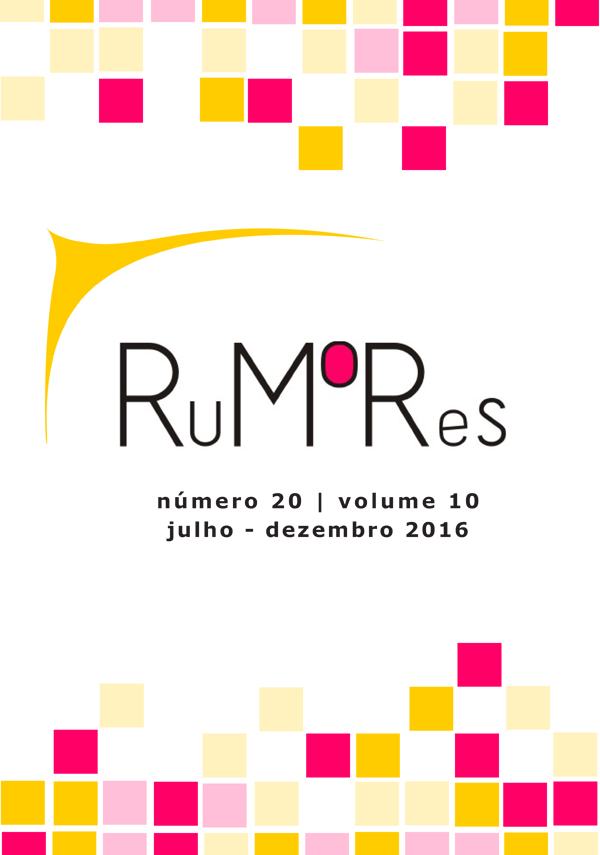The art of the remix: an anarchaeology of digital media creation processes
DOI:
https://doi.org/10.11606/issn.1982-677X.rum.2016.120924Keywords:
theory of the image, digital media, creative processes in media, remixAbstract
Digital media, databases and the logic of the software settle the contemporary culture. In this context, specific procedures of creation and production of language emerge from networks. Being the act of editing fragments of preexisting materials with the aim of generating new works, the remix is a typical digital culture practice. This article starts with a critical revision about the discussion on remix in the digital culture (Lesssig, Manovich, Navas). Then, it discusses the remix as a creative procedure in various media and as an aesthetic choice in the production of media image and imaginary. The montage, according to Max Ernst perspective, is revisited to establish parallels with the remix processes of linking up. In order to study the remix as a language, two case studies are presented.
Downloads
References
AMERIKA, M. Escrita no ciberespaço: notas sobre narrativa nômade, net arte e prática de estilo de vida. In: LEÃO, L. (Org.). O chip e o caleidoscópio: reflexões sobre as novas mídias. São Paulo: Senac, 2005. p. 133-146.
BIRTH of a nation. Direção: D. W. Griffith. New York: Kino Lorber, 1915. Disponível em: <https://www.youtube.com/watch?v=I3kmVgQHIEY>. Acesso em: 19 jan. 2017.
DJ SPOOKY. Rebirth of a Nation. 2004. Disponível em: <https://www.youtube.com/watch?v=3ljIq0lz0qY>. Acesso em: 19 jan. 2017.
DURAND, G. As estruturas antropológicas do imaginário: introdução a arquetipologia geral. São Paulo: Martins Fontes, 2002.
ERNST, M. Qual é o mecanismo da colagem? In: CHIPP, H. B. (Org.). Teorias da arte moderna. São Paulo: Martins Fontes, 1996. p. 432-433.
FOUCAULT, M. As palavras e as coisas. São Paulo: Martins Fontes, 1995.
GUNKEL, D. J. Of remixology: ethics and aesthetics after remix. Cambridge: MIT Press, 2016.
JANIS, H.; BLESH, R. Collage: personalities, concepts, technique. Philadelphia: Chilton Co., 1967.
KRAUSS, R. E. The optical unconscious. Cambridge: MIT Press, 1994.
LEÃO, L. Paradigmas dos processos de criação em mídias digitais: uma cartografia. V!RUS, São Carlos, n. 6, 2011. Disponível em: <http://www.nomads.usp.br/virus/virus06/?sec=3&item=1&lang=pt>. Acesso em: 15 ago. 2016.
LAS MENINAS. Direção: Juan Downey. New York: MoMA. 1975. 20 min.
LESSIG, L. Remix: making art and commerce thrive in the hybrid economy. New York: Penguin Press, 2008.
MANOVICH, L. What comes after Remix? 2007. Disponível em: <http://manovich.net/content/04-projects/057-what-comes-after-remix/54_article_2007.pdf>. Acesso em: 11 jan. 2017.
MILLER, P. D. Rhythm science. Cambridge: Mediawork/MIT Press, 2004.
______. Sound unbound: sampling digital music and culture. Cambridge: MIT Press, 2008.
MUNIZ, V. Pictures of junk. Série de fotografias. Acesso em: <http://vikmuniz.net/gallery/junk>. Acesso em: 19 jan. 2017.
______. Narciso, depois de Caravaggio. Impressão a cores cromogênica. 2005. Disponível em: <http://warburg.chaa-unicamp.com.br/obras/view/3963>. Acesso em: 19 jan. 2017.
MUSEU PICASSO. Forgetting Velázquez. Las Meninas. 2008. Disponível em: <http://www.museupicasso.bcn.cat/meninas/Forgetting_Velazquez_Las_Meninas.pdf>. Acesso em: 19 jan. 2017.
NAVAS, E. The three basic forms of remix: a point of entry. 2007. Disponível em: <http://www.remixtheory.net/?p=174>. Acesso em: 17 ago. 2016.
OWENS, C. The allegorical impulse: towards a theory of postmodernism. In: WALLIS, B. (Ed.). Art after modernism: rethinking representation. New York: New Museum of Contemporary Art, 1984.
PICASSO, P. Les ménines. 1957. Série de 58 pinturas.
______. O rapto das sabinas. 1962. Óleo sobre tela.
POUSSIN, N. O rapto das sabinas. 1637-1638. Óleo sobre tela.
PLAZA, J. Tradução intersemiótica. São Paulo: Perspectiva, 1987.
SPIES, W. Max Ernst collages: the invention of the surrealist universe. Tradução de John William Gabriel. New York: Abrams, 1991.
SODERBERG, J. Read my lips. 2002. Disponível em: <https://www.youtube.com/watch?v=g6-NDTWM8VE>. Acesso em: 19 jan. 2017.
STRUTH, T. Las meninas by Velásquez (Prado). 2005. Fotografia. Disponível em: <http://www.npr.org/2016/10/31/499443750/photography-writ-large-the-monumental-art-of-thomas-struth>. Acesso em: 19 jan. 2017.
VEGA, H. B. Double éclairage sur occident, Velázquez et Picasso. 1987. Óleo sobre tela.
VELÁZQUEZ, D. Las meninas. 1656. Óleo sobre tela.
WARLICK, M. E. Max Ernst and alchemy: a magician in search of myth. Austin: University of Texas Press, 2001.
ZIELINSKI, S. Arqueologia da mídia: em busca do tempo remoto das técnicas do ver e do ouvir. São Paulo: AnnaBlume, 2006.
Downloads
Published
Issue
Section
License
Declaro a total e irrestrita cessão de direitos autorais sobre o texto enviado para publicação na Rumores – Revista Online de Comunicação, Linguagem e Mídias. Entendo que o conteúdo do artigo é de minha inteira responsabilidade, inclusive cabendo a mim a apresentação de permissão para uso de imagens, ilustrações, tabelas, gráficos de terceiros que, porventura, venham a integrá-lo.









